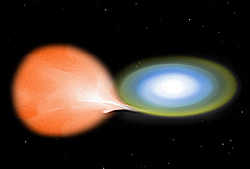
A nova is a transient astronomical event that causes the sudden appearance of a bright, apparently "new" star that slowly fades over weeks or months. Causes of the dramatic appearance of a nova vary, depending on the circumstances of the two progenitor stars. All observed novae involve white dwarfs in close binary systems. The main sub-classes of novae are classical novae, recurrent novae (RNe), and dwarf novae. They are all considered to be cataclysmic variable stars.

The Andromeda Galaxy is a barred spiral galaxy and is the nearest major galaxy to the Milky Way, where the Solar System resides. It was originally named the Andromeda Nebula and is cataloged as Messier 31, M31, and NGC 224. Andromeda has a diameter of about 46.56 kiloparsecs and is approximately 765 kpc from Earth. The galaxy's name stems from the area of Earth's sky in which it appears, the constellation of Andromeda, which itself is named after the princess who was the wife of Perseus in Greek mythology.

V838 Monocerotis is a spectroscopic binary star system in the constellation Monoceros about 19,000 light years from the Sun. The previously unremarked star was observed in early 2002 experiencing a major outburst, and was one of the largest known stars for a short period following the outburst. Originally believed to be a typical nova eruption, it was then identified as the first of a new class of eruptive variables known as luminous red novae. The reason for the outburst is still uncertain, but is thought to have been a merger of two stars within a triple system.

The Pinwheel Galaxy is a face-on spiral galaxy 21 million light-years away from Earth in the constellation Ursa Major. It was discovered by Pierre Méchain in 1781 and was communicated that year to Charles Messier, who verified its position for inclusion in the Messier Catalogue as one of its final entries.

NGC 300 (also known as Caldwell 70) is a spiral galaxy in the constellation Sculptor. It is one of the closest galaxies to the Local Group, and probably lies between the latter and the Sculptor Group. It is the brightest of the five main spirals in the direction of the Sculptor Group. It is inclined at an angle of 42° when viewed from Earth and shares many characteristics of the Triangulum Galaxy. It is 94,000 light-years in diameter, somewhat smaller than the Milky Way, and has an estimated mass of (2.9 ± 0.2) × 1010M☉.

Luminous blue variables (LBVs) are massive evolved stars that show unpredictable and sometimes dramatic variations in their spectra and brightness. They are also known as S Doradus variables after S Doradus, one of the brightest stars of the Large Magellanic Cloud. They are extraordinarily rare, with just 20 objects listed in the General Catalogue of Variable Stars as SDor, and a number of these are no longer considered LBVs.
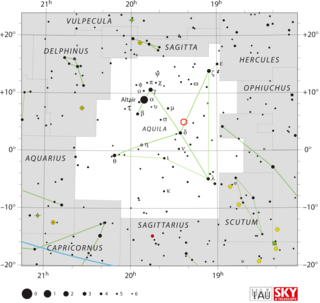
V1494 Aquilae or Nova Aquilae 1999 b was a nova which occurred during 1999 in the constellation Aquila and reached a brightness of magnitude 3.9 on 2 December 1999. making it easily visible to the naked eye. The nova was discovered with 14×100 binoculars by Alfredo Pereira of Cabo da Roca, Portugal at 18:50 UT on 1 December 1999, when it had a visual magnitude of 6.0.

A Type Ia supernova is a type of supernova that occurs in binary systems in which one of the stars is a white dwarf. The other star can be anything from a giant star to an even smaller white dwarf.

A luminous red nova is a stellar explosion thought to be caused by the merging of two stars. They are characterised by a distinct red colour, and a light curve that fades slowly with resurgent brightness in the infrared. Luminous red novae are not related to standard novae, which are explosions that occur on the surface of white dwarf stars.
A luminous supersoft X-ray source is an astronomical source that emits only low energy X-rays. Soft X-rays have energies in the 0.09 to 2.5 keV range, whereas hard X-rays are in the 1–20 keV range. SSSs emit few or no photons with energies above 1 keV, and most have effective temperature below 100 eV. This means that the radiation they emit is highly ionizing and is readily absorbed by the interstellar medium. Most SSSs within our own galaxy are hidden by interstellar absorption in the galactic disk. They are readily evident in external galaxies, with ~10 found in the Magellanic Clouds and at least 15 seen in M31.

In astronomy, a common envelope (CE) is gas that contains a binary star system. The gas does not rotate at the same rate as the embedded binary system. A system with such a configuration is said to be in a common envelope phase or undergoing common envelope evolution.
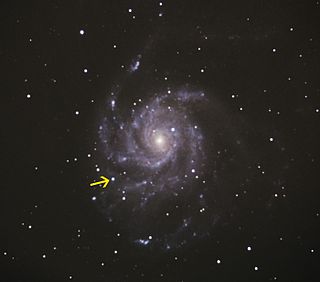
SN 2011fe, initially designated PTF 11kly, was a Type Ia supernova discovered by the Palomar Transient Factory (PTF) survey on 24 August 2011 during an automated review of images of the Messier 101 from the nights of 22 and 23 August 2011. It was located in Messier 101, the Pinwheel Galaxy, 21 million light years from Earth. It was observed by the PTF survey very near the beginning of its supernova event, when it was approximately 1 million times too dim to be visible to the naked eye. It is the youngest type Ia ever discovered. About 13 September 2011, it reached its maximum brightness of apparent magnitude +9.9 which equals an absolute magnitude of about -19, equal to 2.5 billion Suns. At +10 apparent magnitude around 5 September, SN 2011fe was visible in small telescopes. As of 30 September the supernova was at +11 apparent magnitude in the early evening sky after sunset above the northwest horizon. It had dropped to +13.7 as of 26 November 2011.

NGC 2748 is a spiral galaxy in the northern circumpolar constellation of Camelopardalis, located at a distance of 61.3 megalight-years from the Milky Way. It was discovered September 2, 1828 by John Herschel. The morphological classification of SAbc indicates this is an unbarred spiral with moderate to loosely-wound spiral arms. It is a disk-like peculiar galaxy with a stellar shell that is rotating about the main galactic axis. This shell was most likely formed through the capture and disruption of a dwarf companion. The galactic nucleus likely contains a supermassive black hole with a mass of 4.4+3.5
−3.6×107 M☉, or 44 million times the mass of the Sun.

ASASSN-15lh is an extremely luminous astronomical transient event discovered by the All Sky Automated Survey for SuperNovae (ASAS-SN), with the appearance of a superluminous supernova event. It was first detected on June 14, 2015, located within a faint galaxy in the southern constellation Indus, and was the most luminous supernova-like object ever observed. At its peak, ASASSN-15lh was 570 billion times brighter than the Sun, and 20 times brighter than the combined light emitted by the Milky Way Galaxy. The emitted energy was exceeded by PS1-10adi.

M31-RV is a possible red cataclysmic variable star located in the Andromeda Galaxy (M31) that experienced an outburst in 1988, which is similar to the outburst V838 Monocerotis experienced in 2002. Such objects have been called luminous red novae or intermediate-luminosity red transients. During the outburst, both V838 Mon and M31-RV reached a maximum absolute visual magnitude of -9.8.

V906 Carinae, also known as Nova Carinae 2018, was a nova in the Milky Way galaxy which appeared in the constellation Carina, near the 5th magnitude star HD 92063. It was discovered on images taken on 20.32 March 2018 by the All Sky Automated Survey for SuperNovae (ASAS-SN] telescope at the Cerro Tololo Inter-American Observatory. The ASAS-SN group assigned the name ASASSN-18fv to the object. The discovery image was saturated, allowing researchers to determine only that the object was brighter than apparent magnitude 10. An earlier image obtained by ASAS-SN on 26.32 March 2018 showed the nova was a magnitude ~10.4 object at that time, and the object was not detected on ASAS-SN images taken on 15.34 March 2018 and earlier.

SN 2018cow was a very powerful astronomical explosion, 10–100 times brighter than a normal supernova, spatially coincident with galaxy CGCG 137-068, approximately 200 million ly (60 million pc) distant in the Hercules constellation. It was discovered on 16 June 2018 by the ATLAS-HKO telescope, and had generated significant interest among astronomers throughout the world. Later, on 10 July 2018, and after AT 2018cow had significantly faded, astronomers, based on follow-up studies with the Nordic Optical Telescope (NOT), formally described AT 2018cow as SN 2018cow, a type Ib supernova, showing an "unprecedented spectrum for a supernova of this class"; although others, mostly at first but also more recently, have referred to it as a type Ic-BL supernova. An explanation to help better understand the unique features of AT 2018cow has been presented. AT2018cow is one of the few reported Fast Blue Optical Transients (FBOTs) observed in the Universe. In May 2020, however, a much more powerful FBOT than AT2018cow was reportedly observed.
3XMM J004232.1+411314 is a low-mass X-ray binary hosted in the galaxy M31. It is the most luminous source of hard X-rays in the Andromeda Galaxy. It is also the most luminous source known that shows dips in the X-ray light curve. The compact object in this system has been unambiguously identified as a neutron star with a spin period of 3 seconds.
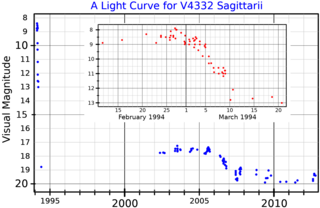
V4332 Sagittarii is a nova-like event in the constellation of Sagittarius. It was discovered February 24, 1994 at an apparent visual magnitude of 8.9 by Japanese amateur astronomer Minoru Yamamoto from Okazaki, Aichi, then confirmed by K. Hirosawa. Initially designated Nova Sagittarii 1994 #1, it was given the variable star designation V4332 Sgr. A spectra of the event taken March 4 lacked the characteristic features of a classical nova, with the only emission lines being of the Balmer series. Subsequent spectra showed a rapid decline in luminosity and a change of spectral type over a period of five days. By 2003, the object was ~1500 times less luminous than at peak magnitude and showed a spectrum of an M-type star.
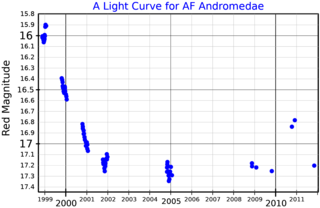
AF Andromedae is a luminous blue variable (LBV), a type of variable star. The star is one of the most luminous variables in M31, the Andromeda Galaxy.
 Discovery image
Discovery image



















